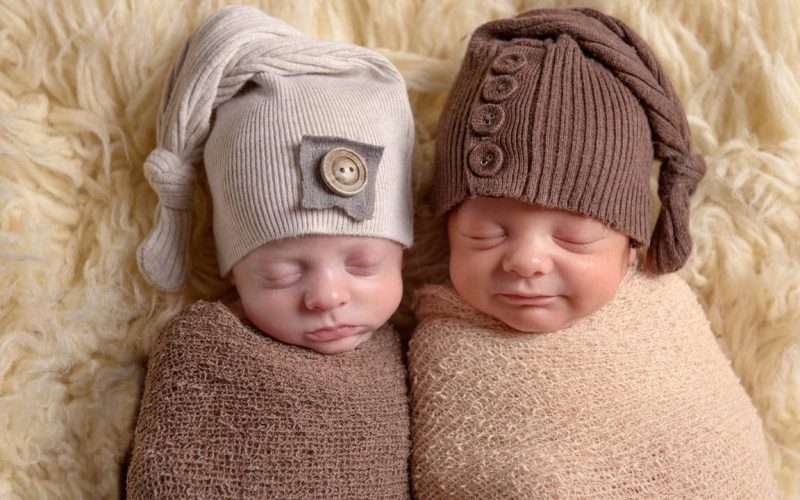Twins are adorable, but not everyone knows there are different kinds of twins. Most twins you see daily are fraternal twins ( that means they are less identical and more like siblings born on the same day).
Here, you learn more about fraternal twinning, from how these twins form to how they relate to each other and how they differ from easily identifiable identical twins.
Fraternal Twins Develop From Two Unique Eggs
Unlike identical twins, fraternal twins come from a separate egg and sperm. The acceptable term for this is dizygotic, while the word for identical twins is monozygotic.
“Di” represents two, and “mono” represents one. Zygotic is a term for the zygote, the egg fertilized by the father’s sperm that develops into an embryo and eventually grows into a baby.
Monozygotic twins (identical twins) come from a single sperm and egg split into two after conception.
Fraternal Twins Can Be the Same or Different Genders
Because fraternal twins come from separate conceptions, it is not uncommon for them to be boys, girls, or one of each gender (same as a singleton baby).
As always, chromosomes from the dad’s sperm determine gender: XX is the chromosome for a female child, while XY is for a male child.
As a result, it is safe to say that the chances of getting fraternal twin boys, girls, or a combination are equal to those of single babies and other numbers of babies.
On the other hand, Monozygotic—identical—twins are always of the same gender, either two boys or two girls.
They Are Always As Genetically Similar As Siblings
Like other siblings, fraternal twins will always share not less than 50% of their DNA.
Each child naturally receives half of its DNA from its father’s sperm and the other half from its mother’s egg, so it is natural for any two offspring to have some qualities that overlap.
However, fraternal twins are not the perfect genetic match we can say identical twins are.
They May Not Act and Look Alike
Monozygotic twins are often tagged “identical” because they have similar character traits and appearances.
These similarities stem from the fact that both siblings share the exact genetic makeup (or the same genotype), although it is not a given that their DNA will be identical.
On the other hand, Fraternal twins are just as alike as any other two siblings. They may not look alike in any way. They can be born with different eye color, hair color, personality, and stature.
Or, they may indeed have so many similarities that they are mistaken for identical twins, just as some siblings may be greatly indistinguishable, except that they are not of the same age.
Twins and multiple babies are also shaped by their experiences and environment after birth.
There is a chance that some similarities will be enhanced because both kids are raised in the same household, share the same life experiences, and get an education in the same schools.
Fraternal Twins Have Two Placentas
The placenta provides needed sustenance to the child during pregnancy. In multiple pregnancies involving fraternal twins, each child gets its placenta. Sometimes, however, the two placentas fuse and emerge as one.
Because some monozygotic twins share one placenta, it can become challenging to determine zygosity in utero.
Having separate placentas is good because such twins do not have to deal with certain risks that monozygotic twins are prone to, such as monoamniotic twins or TTTS.
Twinning Can Run in Families
Fraternal twins occur when more than one fertilized egg is released from the ovaries. Normally, every woman has one egg released from her ovaries every month, but there are times when more than one egg is released.
Some women may even release multiple eggs in each cycle, a condition known as hyperovulation—women who naturally hyperovulate have a greater chance of birthing fraternal twins.
A tendency toward hyperovulating may be a genetic trait. What this means is that fraternal twinning can be seen as hereditary.
For women who have the gene for hyperovulation, they can pass it down to their daughters. Then, her daughters will have increased chances of having fraternal twins.
Because men naturally carry the X (female) and the Y (male) chromosomes, they may also hold the hyperovulation trait.
This means they can also pass it along to their female children, thus upping their daughters’ chances of birthing fraternal twins.
However, while having the gene for hyperovulation increases a woman’s chances of birthing twins, it does not increase a man’s chances of birthing fraternal twins.
This means that If a man carries the hyperovulation gene, it doesn’t affect the ovulation pattern of his wife or partner.
She has genes that govern her ovulation. Instead, his daughter would inherit that trait through his genes. That explains why twins are assumed to possibly “skip a generation.”
Fraternal Twins Can Be Conceived at Varying Times

Usually, only one egg is released during ovulation. But when there is hyperovulation, multiple eggs will be released. Sometimes, that may happen a couple of days apart.
After fertilizing one egg and traveling to the mother’s uterus for implantation, sperm obtained from a later sexual interaction fertilize a different egg.
The outcome is fraternal twins who are conceived a couple of days apart. This process or occurrence is known as superfetation. There are also instances of fraternal twins who have different fathers.
This can occur when a mother releases multiple eggs and proceeds to have sexual relations with more than one man.
If one egg is fertilized by sperm from the first man and then a second egg is fertilized by sperm from a different man, the outcome is fraternal twins with different dads.
This phenomenon is known as superfecundation.
Twinning Rates Have Been Found to Vary Across Populations
Population studies have revealed that some groups of persons have twins much more frequently, while in other populations, twins are rare.
A 2011 study revealed that the highest twinning rates were discovered in Central African populations, while the lowest were found in Asia and Latin America.
Twins Can Be the Outcome of Fertility Treatments
As the growth of medical technology made it easier to access fertility-enhancing treatments, the twin birth rate increased even more in the late 20th century.
Fertility treatments, whether the use of drugs like Clomid or a procedure like in-vitro fertilization (IVF), may sometimes lead to twins or multiples, with the bulk of multiple births being dizygotic. There are also some instances of monozygotic twinning in IVF.
They Can Make a Pregnancy Even Riskier
Twins are known to be affected by your habits and health during pregnancy. While it is natural that non-twin siblings have a different pregnancy environment, you can expect fraternal twins to share either increased or decreased health risks because of the pregnancy environment.
When you get pregnant with twins, it puts more demands on your body than when you have a singleton pregnancy.
There is a much greater risk of preeclampsia, pregnancy-induced hypertension, and gestational diabetes, amongst other conditions.
There is also a greater likelihood of dealing with premature birth. Both identical and fraternal twins would share this risk.
Fraternal Twins Can Result From Many Factors
Many known factors that influence multiple births will only affect fraternal twinning.
This is mainly because the said factors can promote hyperovulation, thus prompting the release of multiple eggs per cycle and raising the chances of birthing twins.
Heredity, Being taller, Maternal age, how many other children you have, and having a higher BMI are all connected with a higher risk of birthing fraternal twins.
There are weaker associations with the use of folic acid, birth control pills, and the season of the year.








